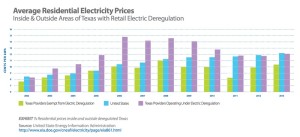The average customer in deregulated Texas continues to pay far more for electricity than folks served by monopoly utilities in cities like Austin and San Antonio,
Republished from the Texas Tribune –
http://www.texastribune.org/2015/08/12/report-deregulated-electric-utilities-narrowing-pr/.
Deregulated Electricity a Mixed Bag for Consumers
by Jim Malewitz
Aug. 12, 2015
More than a decade ago, Texas lawmakers set the state’s power market free. Longstanding rules limiting who sold electricity to whom — and how much they charged for it — were cast aside so private companies could chase customers, competing for business in a free-market bonanza that would supposedly push down prices for consumers across the state.
So did it work?

Texans who take the time to sort through the options are finding decent deals in the state’s deregulated electricity market, a new report says. But the average customer in deregulated Texas — about 85 percent of the state — continues to pay far more for electricity than folks served by monopoly utilities in cities like Austin and San Antonio, according to the most recent data available.
In a report released Wednesday, the Texas Coalition for Affordable Power, which advocates for cities and other local governments, analyzed U.S. Energy Information Administration data on residential prices stretching back to 2002, the first year most Texans were allowed to choose their electricity provider under deregulation.
In 2012 and 2013, the analysis showed, Texans in deregulated areas for the first time paid lower electric bills on average than most Americans.
But from 2002 to 2013, the average household in deregulated areas paid a total of about $4,800 more than residents of cities — like Austin and San Antonio — served by just one municipal utility, or those served by electric cooperatives, the analysis said.
Though pricing data for 2014 and 2015 was not available, the report said, Texans are increasingly finding individual deals on the deregulated market that are cheaper than what regulated utilities offer.
“Texans living in deregulated areas have paid too much for electricity — and the lost savings has been substantial,” Jay Doegey, the coalition’s executive director, said in a statement. “But the deregulated market is improving, and the good news is that if you shop carefully, you can find good deals. These relatively low-cost deals are more common than they were in previous years.”
Nationally, Texas was the 18th cheapest state to power homes between 2002 and 2013, the analysis said. Residents in just nine states saw cheaper prices than Texans in regulated areas during that period. Twenty-six states averaged cheaper prices than Texans in the competitive market.
Why the discrepancy? The coalition and other consumer groups suggest that continued inefficiencies, customer confusion and relatively high prices from legacy electricity providers could be to blame.
A spike in natural gas prices shortly after deregulation, followed by steep decline could have also helped shape the trend, since competitive providers locked into high-cost gas contracts and took years to recover. The coalition acknowledges that factor, but says that it doesn’t account for the trend by itself.
John Fainter, president and CEO of the Association of Electric Companies of Texas, bristles at any suggestion that monopoly utilities offer Texans better deals, but agrees that the competitive market is rapidly evolving and consumers are getting used to it. A state website called Power to Choose allows consumers to compare companies’ prices and complaint history.
“There’s a lot more efficiency. People are better able to manage their electric use,” Fainter said. “The [retail electric providers] are developing more products to take advantage of.”
Wednesday’s report also showed that the steadiest increase in most Texas utility bills isn’t the cost of electricity, it’s the fees charged to deliver it.
Customers can choose whom to buy power from, but monopoly power transmission companies still have to deliver it to homes and businesses. Between 2003 and 2015, the rates of two of Texas’ biggest power line companies — which are regulated by the Public Utility Commission of Texas — rose far higher than inflation, making up an increasing share of consumers’ bills.
CenterPoint, which serves the Houston area, charges nearly $43.94 on the average monthly bill (for those using 1,000 kilowatt-hours of electricity), compared to $24.61 in 2003.
Oncor, which serves the Dallas-Fort Worth area, increased charges to $38.59 from $23.01 during the same period.
One dollar today in 2002 has the buying power of $1.30 today.
Texas rapidly grew during that time frame, Fainter pointed out, embarking on many huge transmission projects, including building new power lines to carry renewable energy and installing millions of “smart meters” to track energy use in hopes of boosting efficiency.
“All of that has to be paid for,” he said.